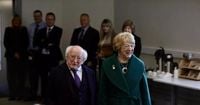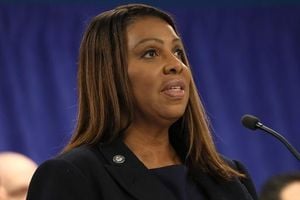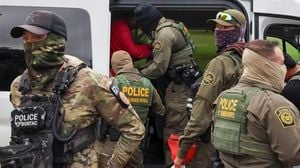On October 24, 2025, Ireland’s electorate headed to the polls to select their next president, capping off a campaign season that was anything but ordinary. As counting began the following morning, all eyes turned to Dublin Castle, where the results would soon reveal whether Catherine Connolly, the left-wing independent favored in the polls, or Heather Humphreys, the centrist Fine Gael candidate, would become the nation’s 10th president—and only the third woman ever to hold the office.
This year’s presidential contest, as reported by The Associated Press, was marked by the absence of a major party showdown. Fianna Fáil’s Jim Gavin, initially a leading contender, withdrew from the race earlier in October after a long-standing rental dispute resurfaced, leaving his name on the ballot but his campaign in disarray. That left Connolly and Humphreys as the only real options for voters, a situation that some critics described as a “two-horse race.”
Connolly, a 68-year-old barrister and independent lawmaker from Galway, entered the campaign with the backing of Sinn Féin, Labour, the Social Democrats, and a slate of independent politicians. Her candidacy, declared as early as July, quickly gained momentum, especially among young voters. According to Al Jazeera, her strong pro-Palestine stance, commitment to social justice, and outspoken criticism of the European Union’s increasing “militarization” struck a chord with those seeking change. She even managed to tap into Ireland’s current cultural resurgence, embracing the Irish language at a time when films like The Quiet Girl and bands such as Kneecap—who urged their fans to support her—were capturing the national imagination.
But Connolly’s campaign was not without controversy. In September, she faced backlash for remarks describing Hamas as “part of the fabric of the Palestinian people,” comments that came under renewed scrutiny following the October 7, 2023, attack on Israel by Hamas. Irish Prime Minister Micheál Martin criticized her reluctance to condemn Hamas outright. Still, Connolly later clarified, stating, “I utterly condemned Hamas’ actions,” while maintaining her criticism of Israel’s conduct in Gaza, which she described as genocide. Her position risked alienating some of Ireland’s allies and drew attacks from political opponents, but also cemented her as a candidate willing to speak her mind—even on the thorniest international issues.
On election day, Connolly arrived at her polling station in Galway’s Claddagh district by bicycle, telling reporters she’d gone for a swim earlier that morning to calm her nerves. “That sort of calmed me down,” she quipped, offering a glimpse into the human side of a campaign that had already weathered more than its fair share of drama. Just days before the vote, a deepfake video surfaced online, purporting to show Connolly announcing her withdrawal from the race. The AI-generated clip, styled as a fake RTE news broadcast, was quickly debunked, but not before sowing confusion and outrage. Despite this, and perhaps even galvanized by it, Connolly’s support appeared to hold steady.
Heather Humphreys, meanwhile, brought her own formidable credentials to the race. At 64, the Fine Gael candidate had served in parliament from 2011 until 2024, holding senior cabinet positions in arts and heritage, business, rural development, social protection, and justice. Raised a Presbyterian in the predominantly Catholic Republic, Humphreys emphasized her centrist, pro-business, and pro-EU credentials, pledging to “build bridges” with Protestant communities in Northern Ireland. “I’m a center-ground person. I’m a middle-of-the-road person, like most Irish people,” she declared during the final presidential debate, as reported by The Associated Press.
Her supporters argued that her background and personal connections could help foster unity across the island—an increasingly important issue as talk of Irish reunification gained traction. However, Connolly was quick to paint Humphreys as a representative of “more of the same,” aligning her with the policies of recent governments and suggesting that a vote for Humphreys was a vote for the status quo.
The presidency in Ireland is a role steeped in tradition but largely ceremonial. The president appoints the Taoiseach (prime minister) after parliamentary approval, signs bills into law, and, if necessary, can dissolve parliament and call new elections. While the office does not have the power to shape legislation, recent presidents have not shied away from voicing their opinions on major issues. Outgoing president Michael D. Higgins, who has served since 2011 and reached his term limit, was known for his outspoken views, particularly on the war in Gaza and NATO spending. According to Al Jazeera, Higgins labeled accusations of anti-Semitism against critics of Israel’s Gaza policies as “slander against Ireland” and even suggested that Israel and its arms suppliers should be excluded from the United Nations. Ireland, alongside Spain, has been among the European Union’s most vocal pro-Palestine advocates, setting it apart from countries like Germany and Hungary, which have maintained strong support for Israel.
The process of becoming a presidential candidate in Ireland is itself no small feat. As outlined by BBC News, hopefuls must secure the nomination of either 20 members of the Oireachtas (parliament) or four city or county councils. Connolly was the first to declare her intention to run, while Humphreys was selected after Fine Gael’s initial candidate, Mairead McGuinness, withdrew for medical reasons in August. Jim Gavin’s late withdrawal, prompted by a 16-year-old rental dispute involving €3,300 owed to a former tenant, left his name on the ballot due to the rules around nomination deadlines. Any votes cast for him would be counted and, if necessary, transferred according to voters’ next preferences.
As voting concluded at 10 p.m. local time on October 24, the initial turnout appeared similar to the 2018 election, when just under 40% of eligible voters cast ballots—a record low. Some 3.6 million people were eligible to vote, with ballots counted across 43 constituencies and early tallies providing hints at the likely outcome. Despite the subdued turnout, the stakes felt high for many, particularly younger voters energized by Connolly’s campaign.
The result, expected late on October 25, would determine who would succeed Michael D. Higgins and be inaugurated at Dublin Castle the following day. Whoever prevailed—Connolly, the outspoken independent with a flair for advocacy, or Humphreys, the steady centrist with deep government experience—would inherit a presidency that, while limited in direct political power, remains a powerful symbol of Irish identity and values at home and abroad.
In a contest shaped by controversy, deepfakes, and a narrowing of choices, the Irish presidential election of 2025 offered a snapshot of a country grappling with its past, present, and future. The new president, whoever she may be, will step into Áras an Uachtaráin with both the hopes and the scrutiny of a nation watching closely.






